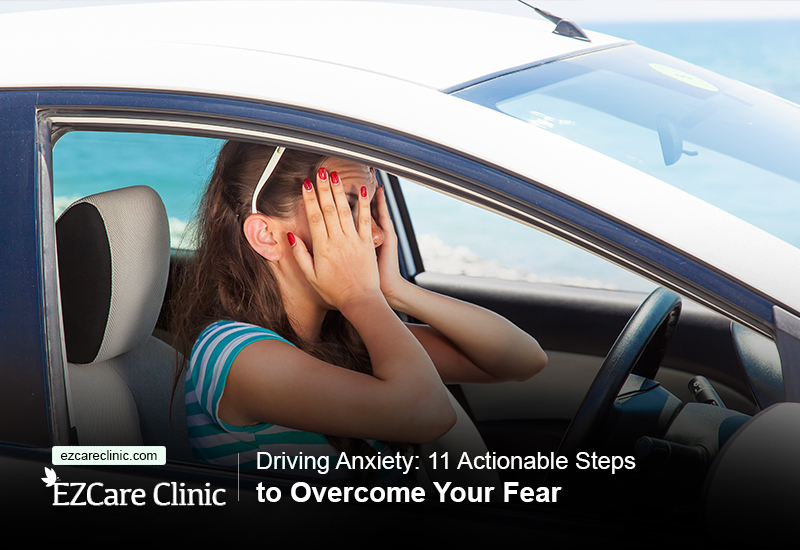Driving anxiety is common and affects people from all over the world. While driving may seem natural to some people, it can evoke fear, anxiety, and panic in others.
If you experience driving anxiety, the very thought of getting behind the wheel can make you nervous. In some cases, driving anxiety can stem from being in a specific situation like driving through tunnels or bridges.
Driving anxiety can be overcome by receiving professional help from a therapist- Click below to book your appointment.
Driving Anxiety: Rational or Irrational Fear?
Fear is categorized as one of seven universal emotions. Although varying in intensity and nuance, everyone experiences fear multiple times throughout life.
In fact, fear is not just unique to humans: animals and other living organisms have been proven to respond to fear.
Fear stems from a real or imagined threat of harm. These could be emotional, physical, or psychological threats.
Traditionally, fear was regarded as a negative emotion. However, this has changed over time as fear has been proven to be a fundamental emotion that keeps you from harm and helps you cope with danger.
Fear can either be rational or irrational.
Rational fear is logical, and the likelihood of your anxiety being actualized is high or could lead to grave danger and damage.
For example, if you’re out in the woods, you may fear being attacked by a bear. As a result of this fear, you’ll take specific steps to minimize the chances of a bear attack.
Irrational fear, on the other end, is likely not to happen in the usual circumstances.
For instance, if you live in the city and are generally afraid of all bears, this could be irrational. Fortunately, there are steps you can take to overcome most fears.
If the fear of driving is not addressed, it can significantly affect your life and those around you.
For instance, driving-induced panic attacks can lead to traffic jams, snarl-ups, and road accidents. On the flip side, altogether avoiding driving can leave you isolated from your friends and alone.
As mentioned earlier, the fortunate thing about fears is you can overcome most of them. And driving anxiety is no different. This article will delve into driving anxiety and how to overcome it.
Throughout this article, keep in mind that driving anxiety is fear, just like any other, and should be treated as such. If at any point you feel you need professional help, guidance, or counseling, do not hesitate to do so.

Top Driving Fears
What Is Driving Anxiety?
Driving anxiety is the intense fear and distress at the thought of driving a vehicle. People with driving anxiety will go to great lengths to avoid driving.
Sometimes, this fear can be so overwhelming that you find it challenging to get into a car, even when you’re not the one driving it. Driving anxiety is also known as amaxophobia, motorphobia, or acrophobia.
In most instances, driving anxiety is common with new and practicing drivers.
Naturally, this fear can go away and become manageable as you become a more proficient driver.
However, there are numerous cases where the motorphobia stuck with the driver even after learning how to drive.
For most novel drivers, driving anxiety is apparent when navigating difficult road obstacles like driving through crowded places or driving on a busy street.
It is important to note that driving anxiety doesn’t affect new drivers only. Experienced drivers can also develop amaxophobia. This is usually the result of an accident, psychological factor, or a multitude of other issues.
Surprisingly, driving anxiety is relatively common among drivers. However, since the degree it impacts your driving can vary, it may go unnoticed for a long time. One peculiar example is people who find it hard to drive under specific conditions.
For example, if you can’t drive under particular weather or during particular times, you may have motorphobia. It is only in more pronounced levels when the condition is easily detectable. This is usually because people affected by driving anxiety in a significant way will do almost anything not to drive.
What Are the Symptoms of Driving Anxiety?
The symptoms of driving anxiety can vary widely. While some may only experience minor discomfort, others may deal with severe agony when trying to drive.
Like most phobias, driving anxiety isn’t always easy to detect.
Most of the associative telltale signs are common in other phobias and conditions as well. As such, it’s vital to get a professional assessment if you think you could be experiencing driving anxiety.
Moreover, qualified personnel can also determine if the signs are indicative of other psychological conditions.
Feelings of fear and restlessness whenever you feel compelled to drive. These feelings are often persistent, irrational, and excessive and can generally get worse with time.
The most common signs and symptoms of driving anxiety are:
- A strong desire to get away from vehicles
- Sweaty palms
- Rapid breathing
- Disorientation
- Dizziness
- Confusion
- Increased heartbeat
- Feeling like you’re losing control
- Feeling like you’re about to pass out
These symptoms can occur individually or as a combination. If you notice any of these whenever you’re driving, you could be suffering from driving anxiety.
The anxiety symptoms that you may be facing can be overcome- Click the button below to schedule your appointment.
Why Do You Get Anxious About Driving?
There’s no one specific explanation why people experience driving anxiety. Having a panic attack when driving can be triggered by various factors.
Some of the common plausible factors that may lead to driving anxiety include:
1. A Family History of Anxiety Attacks
Anxiety and panic disorders can pass through family generations. If your parents struggled with anxiety, there’s a chance that you too could develop the condition. However, that doesn’t mean you’re predisposed to motorphobia if one or both of your parents has a history of panic or anxiety attacks.
2. Traffic Accidents
Getting into an accident is a major fear for most drivers. A person may fear driving because of a particularly traumatic car accident either witnessed or experienced.
Additionally, an independent study reveals about 30% of drivers involved in road accidents end up developing Post-traumatic Stress Disorder (PTSD).
3. Unmanageable Stress and Life Changes
Stress can lead to a number of conditions and ailments when not adequately managed. Stress affects your ability to perform most tasks and generally lowers your confidence in various aspects.
When you’re stressed or going through a significant change in life, you could find driving harder and lose faith in your driving skills.
4. Panic Attacks
Panic attacks are a sudden and severe anxious emotion that’s usually unreasonable.
Panic attacks are typically accompanied by symptoms that can be extremely worrying for the person experiencing them.
These symptoms are:
- Sweating
- Racing heart
- Shortness of breath
Since panic attacks happen without warning, they can lead you to fear being in situations that can harm others or yourself, like driving.
How Can You Know If You’re Suffering from Driving Anxiety?
It is not unusual to be anxious about driving at certain times or in certain conditions.
Various road situations call for an expert driver, and these can make any driver a little nervous. However, if you have a never-ending fear about being in the driver’s seat, this could be a sign of driving anxiety.
Apart from the above-mentioned telltale signs and symptoms of an anxious driver, there are various driving psychological assessment tests to help determine if you have driving anxiety.
These tests measure several factors and variables spanning from specific symptoms to measuring specific kinds of driving anxiety. The driving Cognition Questionnaire is perhaps the most popular driving anxiety assessment test available for you.
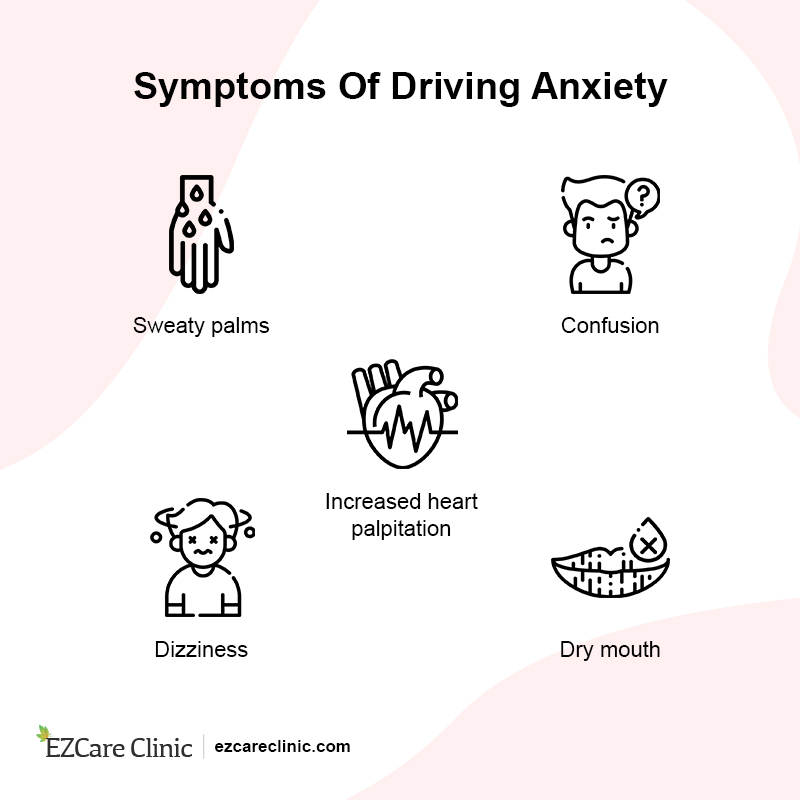
What Does Driving Anxiety Feel Like?
What Tips and Techniques Can Help You Overcome Driving Anxiety?
Some fears are helpful to your survival and self-preservation. For instance, if you see a bear near you, the fear you experience will keep you from approaching the predator. However, some fears are irrational and unhelpful.
Driving anxiety is one of such phobias. In today’s world, driving comfortably is an underrated skill. Whether you’re driving to work or school, taking a road trip, or have an emergency and need to get to the hospital, driving can be helpful in numerous situations.
So, what can you do once you learn you have driving anxiety?
The truth is, overcoming motorphobia is easier said than done. Like many other fears, it’ll take courage, dedication, and self-will to get over the phobia.
Here are a few helpful tips that will gradually help you overcome driving anxiety:
1. Face Your Driving Fear
When it comes to overcoming most phobias, the rule of thumb is you have to face them head-on. Unless you’re willing to tackle the dread, you’ll have difficulty learning how to control yourself and overcome it.
With driving anxiety, you should develop a gradual process to face and overcome the phobia. For example, if you struggle even sitting in the driver’s seat, this would be an excellent place to start for the first few days.
Then, move to the next step, which could be driving the car out of the parkway a few times. Then, try and drive in an empty parking lot for about a week, then move to an open road and gradually increase the levels.
While doing this, you’ll likely be faced with unnerving fear, and you’ll want to quit several times through it. However, you should remember there’s no shortcut when it comes to overcoming phobias.
Ideally, the activities should push you out of your comfort zone. As you continue practicing, you’ll become accustomed to driving and eventually boot the fear.
You can get over your driving anxiety by consulting a mental health expert- Click the banner below to schedule your appointment.
2. Calm Your Mind Before Driving
As with most anxieties and phobias, driving anxiety scrambles your mind and makes it nearly impossible to be coherent or process thoughts as you naturally would.
This only worsens the situation and makes you feel like you can’t drive from fears and mental breakdowns.
To deal with this, you can create a calm environment for your mind anytime you’re about to drive.
By regularly practicing relaxation techniques, you build a wall between your fears and your mind. Daily relaxation techniques can also calm your mind and help you deal with the day’s stresses, including driving.
Here’s a simple and effective relaxation technique you can use during the day:
- Close your eyes and focus on your breathing. Try to calm down and take control of your breathing.
- Inhale gently and deeply through your nose as you count from one to five.
- Exhale slowly and gently through your mouth as you count from one to five.
- Repeat this process several times until you can feel yourself getting calmer. You can repeat this technique several times a day.
Additionally, you can use Progressive Muscle Relaxation (PMR) exercises to take more control of your mind and body. By clenching and loosening targeted muscles, you’ll build awareness of tension retention and release.
To start progressive muscle relaxation techniques, clench your fists for ten seconds and then release them for another ten seconds. Focus on the tension leaving your fists and hands throughout the exercise.
Next, repeat the same process with a different set of muscles. You can move from your hands, up to your head, down your back, and eventually your feet and toes.
For the best results, take about 20 minutes each day to practice PMR exercises. This will help you develop muscle and mind awareness and be more prepared the next time you have a panic attack.
These muscle exercises also help you:
- Control your mood
- Reduce panic attack frequency
- Improve general concentration
3. Practice Positive Affirmations
From the tips above, it is evident the mind plays an integral role in overcoming ochophobia.
A straightforward way to build on your driving confidence is through positive affirmations.
Positive affirmations are short statements you can repeatedly recite in your head to remind yourself that you are capable of overcoming challenging situations.
A few examples of driving anxiety-oriented positive affirmations include:
- I am confident and will resolve the fear of driving
- I believe fear has no grip on me, and I will overcome it
- I am slowly but confidently dealing with driving anxiety in my life
- I believe I will find the solution for driving anxiety
- I choose to live in the present moment, and I am confident about my driving skills and my future
- I am a careful driver, and I drive within the speed limit. Careful driving is safe driving
- I am now beginning to enjoy driving
- I choose to let go of the fear of using the steering wheel
By continually reciting these affirmations, you build your confidence, and when used with the other tips, positive affirmations are powerful and effective.
Practicing positive affirmations is one good way to fight anxiety. Schedule your appointment to get the most suitable driving anxiety treatment.
4. Focus on the Road Ahead of You
Anxiety causes the mind to try and account for every scenario that could happen. In most cases, your mind will only focus on what could go wrong while you’re driving, and this will just worsen the phobia.
To overcome this, try and focus on what is ahead of you. Instead of planning or thinking of what could go wrong, focus on where you are and what you’re doing.
For example, if you’re afraid of crossing bridges, you could easily spend the whole time you’re driving worrying about what happens when you get to the bridge.
This will, of course, impact your concentration and driving skills, which then increases the chances of something going wrong.
In this case, you should follow the proverbial saying and cross the bridge when you get to it. In the meantime, focus on the road ahead of you.
Take note of the car before you and keep your mind from wandering away to the bridge. Once you get to the bridge, take it one step at a time. You can reduce your speed and drive carefully at this stage.
Once you’re over the bridge, take your mind off it and once again focus on what is ahead.
Naturally, the mind will want to focus on the bridge and everything else that could go wrong. It takes practice to control your mind and thoughts, and with time, this will become more natural and easier.
5. Create an Anxiety Scale
As mentioned above, most panic attacks are unprecedented and can happen at any time. This means you have little to no time to react and get yourself back to normal. However, most attacks occur gradually and follow the same pattern.
If you can map out this pattern, you’ll recognize when you’re getting a panic attack and therefore take practical steps to remedy the situation.
Here’s an example of an anxiety scale:
- 0 – Relaxed and calm: you’re at peace and naturally relaxed.
- 1 – Slight anxiety: you feel slightly nervous and more aware and alert than usual.
- 2 – Mild anxiety: your muscles are tense and tingly, and you feel butterflies in your stomach.
- 3 – Moderate anxiety: your heartbeat and breath are increasing, and you feel slightly uncomfortable.
- 4 – Marked anxiety: muscle tension increases, you feel more uncomfortable, and you’re now wondering if you’re able to stay in control.
- 5 – Mild panic: your heart beats faster and irregularly, you feel dizzy, and you’re afraid you’re losing control.
- 6 – Moderate panic: your heart is palpitating, you have difficulty breathing, and you feel disoriented.
- 7 to 10 – Full panic attack: you’re experiencing terror, you’re afraid of dying, and you’re now exhibiting panic attack symptoms.
Your anxiety scale could vary depending on specific factors. However, this is the raw format and progression of an anxiety attack. Recognizing what stage you’re in and what follows next will help you understand what to do next.
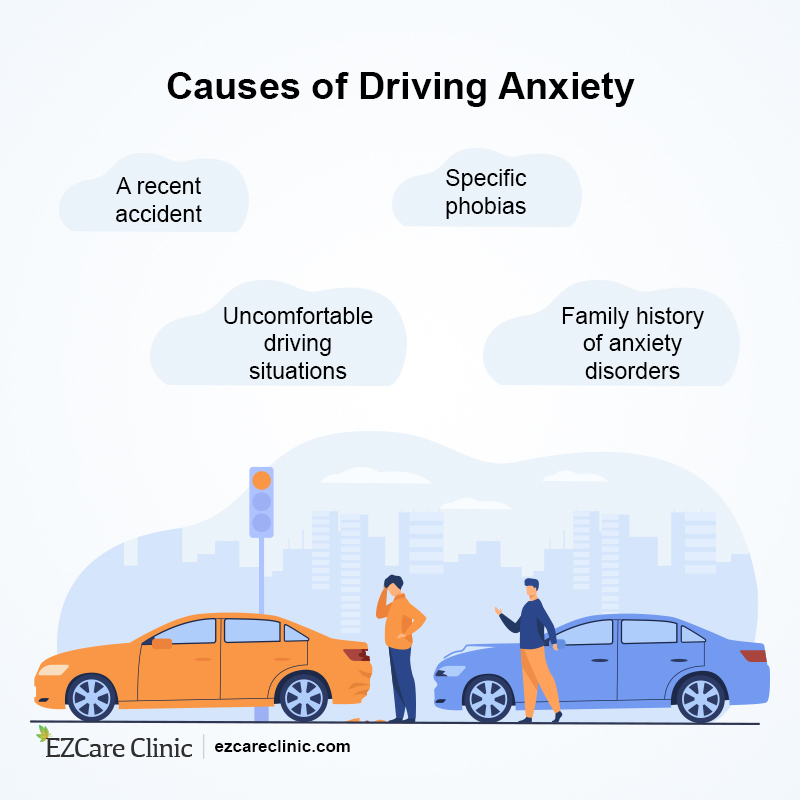
Causes of Driving Anxiety
6. Confront Your Catastrophic Assumptions
A common factor with most irrational fears is they are unlikely to occur. This, however, does not stop the mind from projecting what could go wrong. If you only focus on the occurrence of your fear, you’ll have a difficult time overcoming it.
Driving anxiety sometimes develops from an experience, like an accident or being stuck on a bridge. After these experiences, your mind will only focus on the event happening to you again.
Other times, however, driving anxiety can develop from assumptions and imaginations of what awaits you on the road ahead.
Confronting your assumptions is a great way to deal with anxiety.
Start by asking yourself what it is that you fear about driving. This could be, for example, being afraid of hitting someone, being stuck on a bridge, or causing an accident. Evaluate yourself to determine any biases and assumptions you may be harboring.
Next, break each of these assumptions down. For example, if you’re afraid of causing an accident, what can you do about it? In such a case, you need to remind yourself that careful driving is safe driving.
Moreover, you can take additional driving classes just to build your confidence and drive around in empty spaces to get the hang of your car and the road. The more biases you confront, the easier your driving experience will be.
7. Create a Conducive Driving Environment
Your surroundings have a direct impact and influence on your mental state and wellbeing. If you don’t feel comfortable in your car, you’ll likely be anxious whenever you get in it.
There are several ways to overcome this anxiety, with the most effective being getting used to your car.
Get in your car a few minutes before you have to drive and just sit calmly and take in the environment. This will help you feel accustomed to the space, which could then make you relax.
Soothing music can also help you relax. You can put on something relaxing or your favorite genre before and when you’re driving. Also, ensure your car is clean and fresh before driving. Clutter can make your mind feel uneasy and increase anxiety.
Loud and rowdy passengers can further aggravate your anxiety.
If there’s someone else in the car and you feel uncomfortable, request them to be silent and explain you may not be at ease in an uncontrolled environment. Wearing comfortable clothing also helps improve your control and calmness when driving.
You can get your anxiety attack under control– Click the button below to schedule your appointment with a professional for advice and effective treatment options.
8. Get a Driving Buddy
Driving anxiety can sometimes occur when driving alone, especially when you’re still a new driver. In such cases, you can get someone you’re comfortable with to be in the car when you’re driving.
However, you need to ensure that you’re not reliant on the other party’s presence as they may not always be there. However, a driving buddy is a great idea when you’re building your driving confidence.
You can also share with your close family and friends about your driving anxiety. Having a strong support system can significantly boost your driving confidence. Moreover, your friends may also share tips on how they overcame the fear of driving.
9. Use Your Mind to Overcome Itself
Your mind is more powerful than you may have imagined. Motorphobia is developed in the mind, but you can use the same mind to overcome this fear. While it may sound complex at first, getting inside your mind is not that challenging.
As mentioned above, a significant amount of the fear you feel results from assumptions created in your mind.
By visualizing yourself driving successfully, you can overcome the negative beliefs and build confidence in your driving abilities. Simply take a few minutes to visualize yourself driving through a road and successfully navigating any obstacles.
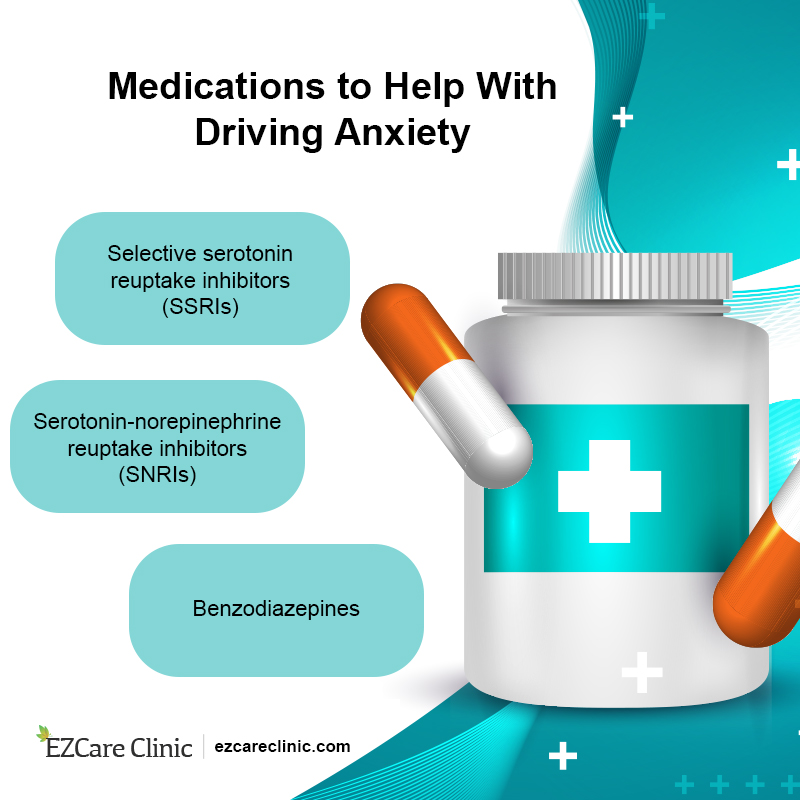
Medications for Driving Anxiety
10. Evaluate Your Life Wholesomely
One aspect of your life can easily spill into other spheres. For example, when you’re stressed, it affects your health, diet, and work. The same goes for driving anxiety. In many cases, the cause of this anxiety is hidden in other spheres of your life.
Evaluate other aspects of your life to see if there are any correlating or causative factors. Stress, for instance, can lead to sleepless nights, feeling lethargic, and inability to concentrate. This can, in turn, impact your ability and confidence to drive.
By solving issues around other areas of your life, you could create a safe space and build your driving skills.
11. Spend Time on the Passenger Seat
If you’re new to driving or haven’t driven in some time, being in the driver’s seat can be unnerving. To get over these nerves, you can spend some time in the passenger seat and get acclimatized to driving.
When possible, get someone you’re comfortable with to drive you around and just watch them.
Watching someone else drive effortlessly will fill you with confidence. Additionally, as you’re in the passenger seat, other cars, the road, and driving will seem more natural, which then helps you overcome your nerves.
Start driving anxiety fear treatment with a licensed mental health professional- Click the button below to schedule your appointment.
What Are the Treatment Options for Driving Anxiety?
The tips and techniques shared above are effective in overcoming ochophobia. Most of these tips can be actualized alone, meaning you can work on your driving anxiety at your pace and without bothering others.
However, it is essential to remember that driving anxiety is just another form of anxiety. And some anxieties need professional intervention to help overcome them. If you feel you’re not making any progress on your own, you can approach a professional for an expert approach.
When it comes to professional treatment options for driving anxiety, psychological therapies are the first line of treatment.
Here are a few therapies that can be used to overcome driving anxiety:
1. Cognitive-Behavioral Therapy (CBT)
Your behaviors and actions are greatly influenced by your feelings, thoughts, and perceptions. By working on your anxious thoughts and feelings, CBT can help you overcome anxiety.
Professionals achieve this by helping you transform negative thoughts into logical and positive ones through rationalization.
Some of the techniques used in CBT include:
- Skill-building
- Writing your reviews
- Behavioral changes
2. Exposure Therapy
This form of therapy involves exposure to specific fear and panic triggers like objects, situations, and events. Being exposed to stimuli under a controlled environment and for a limited time can help you gradually overcome anxiety.
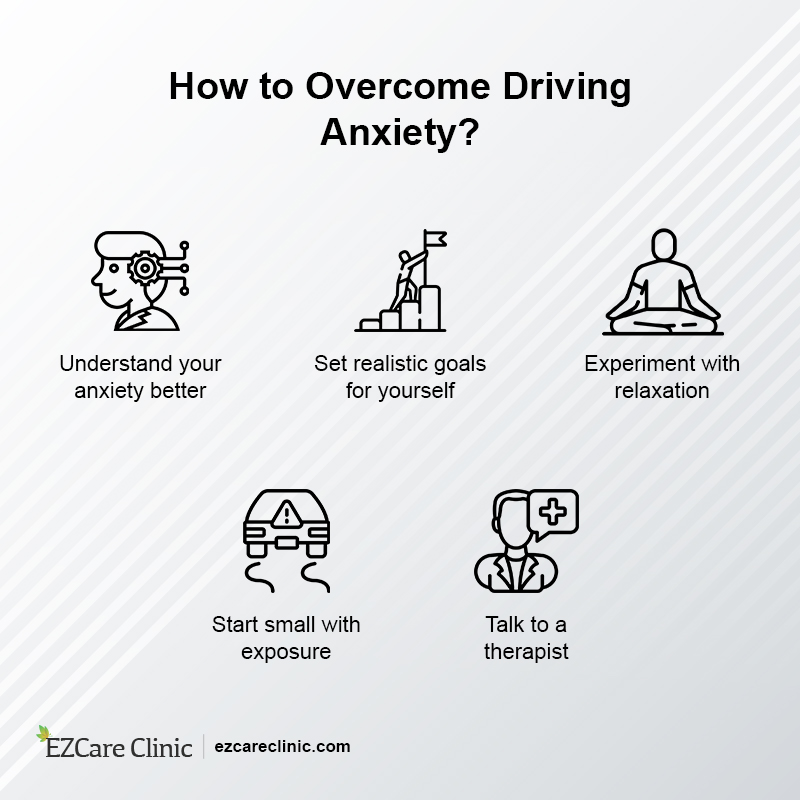
How to Get Over Driving Anxiety?
However, this needs to be done under the strict supervision of specialists and psychologists to ensure nothing goes off-script. Before exposure therapy, the patient is prepped through several counseling sessions. Various types of exposure therapy can be used in different circumstances.
These types include:
- In vivo exposure – involves facing the source of your fear directly.
- Imaginal exposure – involves imagining the trigger cause vividly.
- Interoceptive exposure – involves triggering physical sensations that elicit fear but are harmless. A good example is driving on an empty road.
- Prolonged exposure – A continuous process that combines imaginal and in vivo exposure. Regular sessions may be required to build tolerance against fear and associative triggers.
- Exposure & response prevention – involves doing exposure homework and prevention of the usual situational responses. This type of exposure is mainly used in patients with a history of obsessive-compulsive disorder (OCD).
Professionals may choose to use one form of exposure or combine various types for trusted and lasting results.
3. Online Therapy
If you are reluctant to personal therapy sessions or can’t access reliable services in your area, you can opt for online therapy sessions.
These sessions are just as impactful and helpful as personal ones, and the specialist helps you overcome anxiety through various techniques.
Additionally, the specialist tracks your progress through daily reports, which then helps curate effective remedial processes.
4. Hypnosis Therapy
Hypnotherapy employs hypnotic techniques to help you overcome fear, anxiety, and stress.
The patient is put into a trance state where they are more receptive to suggestions.
Contrary to what most people believe, hypnosis doesn’t give the therapist total control over you. However, your subconscious mind is more alert and receptive to ideas and suggestions.
5. Medications
If the relief techniques and psychological therapies fail to help you overcome driving anxiety, doctors may prescribe medications to help with the process. Some commonly prescribed drugs are Serotonin Selective Reuptake Inhibitors (SSRIs) and Serotonin-Norepinephrine Reuptake Inhibitors (SNRIs). If you’re prescribed any medication, make sure you discuss their effects and when it is safe to drive.
Conquering driving anxiety is possible but it usually requires professional help- Click below to schedule your appointment.
Final Words
Ultimately, it’s key to recognize that driving is a skill, and you can get good at it with time, training, and practice. Moreover, numerous people feel nervous when behind the wheel. Fortunately, driving anxiety is manageable and treatable.
The above-mentioned tips, therapies, and medications can help you overcome nerves when driving. It’s important to recognize the symptoms of driving anxiety early enough so as to seek help and prevent the condition from deteriorating.
Click the banner below to schedule your appointment with a mental health professional at EZCare Clinic.
